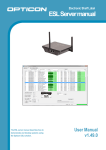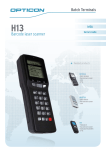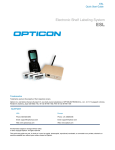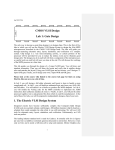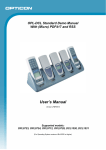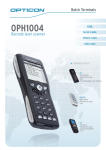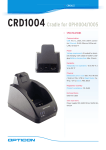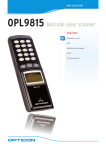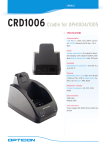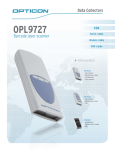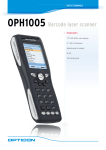Download ESL Demo Kit User Manual
Transcript
Electronic Shelf Label DEMO KIT The ESL demo kit is intended for demonstration and development purposes of the Opticon ESL solution. User Manual Opticon ESL DEMO KIT User Manual All information in this manual is subject to change without notice. Document History Model Number: ESL DEMO KIT Specification Number: Edition: 1.0.0 Original Spec Number: Date: 2013 Copyright 2013 Opticon. All rights reserved. This manual may not, in whole or in part, be copied, photocopied, reproduced, translated or converted to any electronic or machine readable form without prior written consent of Opticon. Limited Warranty and Disclaimers PLEASE READ THIS MANUAL CAREFULLY BEFORE INSTALLING OR USING THE PRODUCT. Serial Number A serial number appears on all Opticon products. This official registration number is directly related to the device purchased. Do not remove the serial number from your Opticon device. Removing the serial number voids the warranty. Warranty Unless otherwise agreed in a written contract, all Opticon products are warranted against defects in materials and workmanship for two years after purchase. Opticon will repair or, at its option, replace products that are defective in materials or workmanship with proper use during the warranty period. Opticon is not liable for damages caused by modifications made by a customer. In such cases, standard repair charges will apply. If a product is returned under warranty and no defect is found, standard repair charges will apply. Opticon assumes no liability for any direct, indirect, consequential or incidental damages arising out of use or inability to use both the hardware and software, even if Opticon has been informed about the possibility of such damages. Packaging The packing materials are recyclable. We recommend that you save all packing material to use should you need to transport your scanner or send it for service. Damage caused by improper packaging during shipment is not covered by the warranty. Trademarks Trademarks used are the property of their respective owners. Opticon Inc. and Opticon Sensors Europe B.V. are wholly owned subsidiaries of OPTOELECTRONICS Co., Ltd., 1217, Tsukagoshi 4-chome, Warabi-shi, Saitama, Japan 335-0002. TEL +81-(0) 48-446-1183; FAX +81-(0) 48-446-1184 SUPPORT USA Europe Phone: 800-636-0090 Phone: +31 235692728 Email: [email protected] Email: [email protected] Web: www.opticonusa.com Web: www.opticon.com 2 Opticon ESL DEMO KIT User Manual Contents 1. Features and Specifications ....................................................................................................... 5 1.1. Abstract ................................................................................................................................ 5 1.2. Contents ............................................................................................................................... 5 1.3. Physical Features ................................................................................................................ 5 1.3.1. Dimensions ............................................................................................................................... 5 1.3.2. Weight ....................................................................................................................................... 5 1.4. Environmental Specifications ............................................................................................... 6 1.4.1. Operating Temperature and Humidity (EE200) ........................................................................ 6 1.4.2. Storage Temperature and Humidity (EE200) ........................................................................... 6 1.5. Interface Specifications ........................................................................................................ 6 1.6. Hardware Specifications ...................................................................................................... 7 1.7. Electrical Specifications ....................................................................................................... 7 1.7.1. Electrical Characteristics .......................................................................................................... 7 1.7.2. Main Battery: ............................................................................................................................. 8 1.8. Serial Number ...................................................................................................................... 9 1.8.1. EBS-30 ..................................................................................................................................... 9 1.8.2. EE200 ....................................................................................................................................... 9 1.9. Safety ................................................................................................................................... 9 1.9.1. Shock ........................................................................................................................................ 9 1.9.2. Temperature Conditions ........................................................................................................... 9 1.9.3. Foreign Materials ...................................................................................................................... 9 1.9.4. Other ......................................................................................................................................... 9 2. Solution Overview ..................................................................................................................... 10 3. Getting started ........................................................................................................................... 11 3.1. Setting up the hardware and software ............................................................................... 11 3.1.1. Installing the ESL Demo kit ..................................................................................................... 11 3.1.2. Installing and finding the EBS30 base station ........................................................................ 12 3.1.3. Installing and activating the ESLs ........................................................................................... 13 3.1.4. Mounting ESLs ....................................................................................................................... 13 3.2. Configuring the base station .............................................................................................. 14 3.2.1. Configuring the RF channel .................................................................................................... 14 3.2.2. Changing the local name ........................................................................................................ 15 3.2.3. Changing the PAN ID ............................................................................................................. 15 3.2.4. Configuring the Ethernet settings ........................................................................................... 16 3.2.5. Factory default ........................................................................................................................ 17 3 Opticon ESL DEMO KIT User Manual 3.3. Configuring of ESLs ........................................................................................................... 18 3.3.1. Associate interval .................................................................................................................... 19 3.3.2. Poll Interval ............................................................................................................................. 19 3.3.3. Poll timeout ............................................................................................................................. 19 3.3.4. Display orientation .................................................................................................................. 19 3.3.5. Poll - Info Ratio ....................................................................................................................... 20 3.3.6. Scan channels ........................................................................................................................ 20 3.4. Monitoring of ESLs ............................................................................................................. 20 3.5. Installing the bar code terminal .......................................................................................... 22 3.6. Data base configuration ..................................................................................................... 23 3.6.1. Changing the database format and settings ........................................................................... 23 3.6.2. Manual editing of the product database .................................................................................. 26 3.6.3. Manual editing of the product-ESL link database ................................................................... 26 4. Designing the ESL image layout .............................................................................................. 27 4.1. Editing the Template Selection File ................................................................................... 29 4.2. Editing the Image layout templates .................................................................................... 30 4.2.1. Using Example data ................................................................................................................ 31 4.2.2. Text ......................................................................................................................................... 34 4.2.3. Rectangles .............................................................................................................................. 35 4.2.4. Lines ....................................................................................................................................... 35 4.2.5. Images .................................................................................................................................... 36 4.2.6. Barcodes ................................................................................................................................. 36 5. Setting up the back office link.................................................................................................. 38 5.1. Product database format .................................................................................................... 38 5.2. Product-ESL link database format ..................................................................................... 39 5.3. Middleware application ...................................................................................................... 41 6. Barcode terminal application ................................................................................................... 42 6.1. Setting up the barcode terminal ......................................................................................... 42 6.2. Loading the database files on the terminal ........................................................................ 43 6.3. Creating links between ESLs and products ....................................................................... 43 6.3.1. OPH1004, H13 or OPL9728 ................................................................................................... 43 6.3.2. OPN2002 ................................................................................................................................ 44 6.4. Sending the modified link-database back to the PC .......................................................... 45 7. Version history .......................................................................................................................... 45 Appendix A: Demo barcodes ......................................................................................................... 46 4 Opticon ESL DEMO KIT User Manual 1. Features and Specifications 1.1. Abstract This manual provides a preliminary description on how to set-up a customized Electronic Shelf Labels (ESL) project with e-Paper ESLs from Opticon Sensors Europe BV. 1.2. Contents The ESL demo kit consists of the following components: • Ethernet ESL base station (EBS-30) • 6 2” e-paper ESLs (EE200) including 6x2 CR2450 batteries • UTP cable • 6.0V 2A Power supply (European) • PC Installation Software + examples • Opticon Demo Kit User Manual The demo kit does NOT include a barcode terminal, which can be used to link ESLs to products using barcodes. Any of the following Opticon Barcode Terminals can be used for this purpose: • OPH1004 (+ CRD1001 cradle) • H13 (+ CRD13 cradle) • OPL9728 (+ CRD9723RU cradle) • OPN2002 (+ mini USB cable) • H21 / H22 (using Wifi) 1.3. Physical Features 1.3.1. 1.3.2. Dimensions 2” e-paper ESL (EE200): W 70.0 x D 32.0 x H 15.0 mm Base station (EBS-30): W 145.0 x D 110.0 x H 30.0 mm (excl. antenna) Weight 2” e-paper ESL (EE200): 25 g (incl. 2 batteries) Base station (EBS-30): 125 g (excl. power supply) 5 Opticon ESL DEMO KIT User Manual 1.4. Environmental Specifications 1.4.1. Operating Temperature and Humidity (EE200) Temperature: 0 to 50° C Humidity: 0-85% 1.4.2. Storage Temperature and Humidity (EE200) Temperature: -20 to 60° C Humidity: 0-85% 1.5. Interface Specifications The radio interface of both the base stations and ESLs have the following specifications: • 2.4gHz IEEE 802.15.4 compatible • Transmission speeds: up to 250 kbps 6 Opticon ESL DEMO KIT User Manual 1.6. Hardware Specifications Items CPU Specifications Remarks Type Stellaris LM3S9B96 (EBS-30) CC2530-F128 (EE200) Internal ROM 256 KB (EBS-30) 128 KB (EE200) Internal RAM 96KB (EBS-30) 8 KB (EE200) 8MB (EBS-30) External RAM Display (EE200) Connector (EBS-30) Radio N/A (EE200) Clock frequency 100 MHz (EBS-30) 32 MHz (EE200) Active area W 45 x H 22 mm Number of dots W 200 x H 96 Model EG020AS183 Gray scale level 1 bit Contrast ratio 10:1 Pixel pitch 111 dpi Ethernet 10/100 Mbit Frequency 2.4gHz Protocol IEEE 802.15.4 Black and white 1.7. Electrical Specifications 1.7.1. Electrical Characteristics EE200: Parameter Typical Unit Remarks Operating voltage 2.8–3.2 V 2 x CR2450 Lithium battery Operating current 7-33 mA During RF and image refresh only 1 uA EE200 is in sleep state >99,9% Typical Unit Remarks Operating voltage 6.0 V Power adapter Operating current <300 mA Sleep current EBS-30: Parameter 7 Opticon ESL DEMO KIT User Manual 1.7.2. Main Battery: The main batteries in the EE200 are 2 CR2450 Li-Mn batteries: • Nominal capacity: 2x600 mAh • Nominal voltage: 3V. • Low voltage: Less than 2.8 V • Operating time: >8 years (default settings; 4 refreshes/day; 15-25° C) The operating time of the batteries is based on a realistic estimation of any of the following factors that influence the battery life: Factor Polling for data & reporting settings Display updates Out of range / base station OFF % Sleep time Battery self-discharge Default values and Correlation * Influence estimated averages (Higher is better) Interval: 20 seconds Retransmissions: 10% Report ratio: 1 to 39 4 per day Temperature: 15-25° C Not connected: 2% Number of channels: 5 99,9% 1 % / year Yes No Yes No No No No Yes 61% No 6% 20% 4% 9% * The correlation shows whether increasing the listed value increases or decreases the power consumption of the ESLs. For example: • Increasing the poll interval lowers the power consumption • Turning off the base stations increases the power consumption • A lower operating temperature increases the power consumption • More display updates per day increase the power consumption 8 Opticon ESL DEMO KIT User Manual 1.8. Serial Number 1.8.1. EBS-30 The serial number can be found on the back of the Base station. The EBS-30 also has a unique MAC-address which is used for both Ethernet and radio communication. 1.8.2. EE200 The serial number of the ESLs is based on the 16 hexadecimal digits MAC-address of the RF-module. However, the first 6 digits of the MAC address (00124B) have been replaced by the letter ‘A’. The default barcode that is shown on the display of the ESL is identical to the bar code on the back of the ESL. 1.9. Safety Handle this product carefully. Do not deliberately subject it to any of the following. 1.9.1. Shock Do not throw or drop the devices 1.9.2. Temperature Conditions Do not use the devices at temperatures outside the specified range. Do not pour water on the devices. Do not throw the devices into the fire. Do not forcibly bend the cable at low temperatures. 1.9.3. Foreign Materials Do not immerse the devices in liquids. Do not subject the devices to chemicals. 1.9.4. Other Do not plug/unplug the connectors before disconnecting the power. Do not disassemble this product. The device may be damaged by power surges 9 Opticon ESL DEMO KIT User Manual 2. Solution Overview The current solution operates by running the provided ESL server application that: • Monitors an input folder in which product databases are being placed by a back office system and processes them. • Can control, monitor and configure ESLs and base stations • Allows manual editing of product and link data bases • Creates/changes image templates, generates the ESL images and sent them to the ESLs A global overview of the current solution is shown below. The following chapters will describe the different parts of this system in more detail and how to get started. Places product modifications as CSV-‐file into shared folder. Retrieve status reports • • • • Back office Parse product modifications into a combined CSV-‐database containing all product info. Parse new ESL-‐product links into a combined CSV-‐database containing all links (optional) Generate truncated article database (CSV-‐format) for the barcode terminal. Middleware application • Create / rename file event ESL server application Cradle or Wifi Ethernet • EBS10 EBS30 • Barcode terminal • • • • • Receives product and link information from ESL server application Create/modify links between ESLs and products (optional) Edit prices/content of products Transmit new/changed ESL-‐product links back to server application. ESLs 10 ESLs ESLs Forwards ESL status & settings information to PC Sends images / commands from server application to ESLs Handles software updates for ESLs • • • • Display images Provide status reports Poll for data Search base stations Opticon ESL DEMO KIT User Manual 3. Getting started 3.1. Setting up the hardware and software This SDK contains the following pieces of hardware and software that will have to be installed in order to get an ESL demonstration or pilot up and running: The ESL Demo kit installer containing: o The ESL server application o Middleware application o Example database files and image templates o Firmware for the barcode terminal, base station and ESLs o Appload (optional) o USB drivers for the barcode terminal cradle (optional) o User manual • 1 EBS30 Base station(s) that includes: o 6V Power supply o Ethernet cable • 6 EE200 2-‐inch e-‐paper ESLs (batteries included) If you want to be able to quickly link ESLs to products, you can use either an: • OPH1004, H13, OPN2002 or OPL9728 barcode terminal (incl. communication cradle/cable) or • H21 or H22 using Wifi (requires a local web server) • 3.1.1. Installing the ESL Demo kit To install and run the software you will also need a PC running Windows 7 or Windows XP (with server pack 3) as server. Before installing the software, make sure you have administrator rights and the PC is fully updated with al Windows updates, including the latest Internet Explorer updates. If your PC doesn’t have .NET Framework 3.5 (or higher) installed, the installer will automatically install it on your system, since the ESL Server application requires it to run. Run the SDK installer by starting the ‘setup.exe’ file. Select the components that you wish to install. If you haven’t installed Appload or the Opticon USB drivers on your PC before, make sure you install those components as well. 11 Opticon ESL DEMO KIT User Manual 3.1.2. Installing and finding the EBS30 base station The base station can easily be installed by powering it up, connecting it to the Ethernet and placing it within 10 meter (the actual maximum range is bigger) of your ESLs. The PC will need to be connected to the same LAN, so it can communicate with the base station*. After starting the application for the first time, no base station will be available to communicate with ESLs. Press the ‘Find’ button on the ‘Base stations-tab to find the connected base station. Select the discovered base station and then press the ‘Add’ button to connect your PC with the base station.* If activated ESLs are nearby, then the ESL count will start incrementing as they start connecting to the base station. However if the ESLs are still ‘deactivated’, they will first have to be reactivated. * Please note that when the base station is connected to the LAN with DHCP the IP address can vary over time, making it necessary to remove the old base station entry by pressing the ‘Delete’-key of your keyboard and discovering the base station again using the ‘find' button. Using static IP leases in the DHCP server can resolve this problem. 12 Opticon ESL DEMO KIT User Manual 3.1.3. Installing and activating the ESLs On arrival the ESLs usually already have their two CR2450 batteries inserted. If not, the batteries can be easily inserted by removing the back shell. However, to allow safe transport by airplane, it is likely that the ESLs will show a ‘DEACTIVATED’ message in their left top corner. This means the ESLs do not emit any radio signals and won’t be searching for base stations at this point. To reactivate these ESLs place them nearby the connected base station and select the base station in the list view of the ‘Base stations’-tab. This allows you to press the ‘Reactivate ESLs’ button in the bottom right corner. After pressing this button, a dialog will appear showing a progress bar and how many ESLs have been reactivated so far. Since the ESLs will only wake-up for a split second every few minutes, it can take more than 15 minutes before all ESLs have been successfully reactivated. You can verify this by checking whether the ‘DEACTIVATED’ message has disappeared from the screen. Active ESL’s will be periodically seek for an Opticon base station, so as soon as an Opticon base station is within range, they will associate with it and start sending data requests and status information to it. When a base station is turned off or an ESL is moved out of range, an ESL will time out after a couple of minutes and starts seeking for another base station in range. See chapter 3.3 for more information about configuring ESLs. It might be possible that even though the ESLs are working properly, they still don’t connect the base station. This might be caused by (Wifi) interference on the default RFchannel of the base station. To resolve this problem, see chapter 3.2.1 3.1.4. Mounting ESLs Since there are many types of mounting clips to mount shelf labels to shelves, the ESLs of the demo kit are supplied without mounting clips. Please contact Opticon for more information on the mounting possibilities of our ESLs to your shelves. For simple demonstration purposes with small amounts of labels one might also consider using double sided foam tape as a temporarily solution. 13 Opticon ESL DEMO KIT User Manual 3.2. Configuring the base station Base stations have very few configurations besides the configuration of the Ethernet settings (which will be described in chapter 3.2.4). The only vital configuration is the RF channel on which the base station operates. 3.2.1. Configuring the RF channel The base station operates on a single RF channel, which can be selected in a range of channel 11 to 26 (as specified by the IEEE 802.15.4 standard). When using multiple base stations it’s strongly recommended to use a different RF channel for each base station within range to improve the maximum throughput of data and reduce data collisions. Since the base station / ESLs, which apply the IEEE 802.15.4 standard, operate on the same frequency band as i.e. WIFI and Bluetooth it’s important to make sure that a base station does not operate on the same RF channel as any nearby WIFI network to minimize interference. To detect which RF-channels are least active, the base station can perform an energy scan on all 16 available channels and graphically show the energy levels in a real-time graph. To check the energy levels on the RF bandwidth select the base station in the ‘Base stations’-tab and press the ‘Scan’ button. Since the EE200 ESLs will (by default) only look for base stations on channels 11, 15, 20, 25 & 26. Look for the RF channel with the lowest energy level (on average) of these 5 channels. If the RF channel of the base station is set to a channel outside this selection, the ESLs will not find the base station. If you do wish to use any of the other channels, then it’s necessary to first configure a different RF channel selection into the ESLs before 14 Opticon ESL DEMO KIT User Manual configuring the base stations. (See chapter 3.3.6) Note: If an ESL is not associating to any base station and its RF channel range is unknown, then configure a base station to channel 11. This channel will always be scanned by an ESL to make sure they can always be found and reconfigured without having to look for it on all channels. After determining the least active RF-channel, close the RfScan-dialog. After that you can change the ‘RF Channel’ in the ‘Configuration’ section of the ‘Base stations’-tab and press ‘Apply’ to confirm. After the RF channel is changed the base station will automatically reset to apply the new setting. Be aware that any ESLs that were already associated with the base station before changing the RF channel will lose their connection with the base station. By default it will take 30 polls (times the poll interval of 20 seconds) before the ESLs will time out and start looking for another base station. To avoid having to wait a couple of minutes before the ESLs starts looking for the base station on the new RF-channel it’s possible to disassociate all the ESLs from the base station prior to changing the RF channel. To do so, select all ESLs in the ‘ESLs’-tab that need to be disassociated, then select the ‘Kick from base station’ action and press the ‘Start’ button. All ESLs should now start disassociating from base station. Once they’re all gone, quickly change the RF channel and the ESLs should start to reappear again on the new channel. 3.2.2. Changing the local name To make it easier to distinguish multiple base stations, it’s possible to assign a name to base stations. This can be done by editing the text field besides ‘Local name’ and pressing the ‘Apply’ button afterwards to store the name inside the base station. 3.2.3. Changing the PAN ID Base stations are addressed by the ESLs by their PAN ID (2 bytes) and a 16-bit shortaddress. This makes it possible to have multiple base stations operating on the same RF channel. By default PAN ID is the same as the 2 least significant bytes of the MACaddress. In the extremely rare case that you will have two base stations that have the same default PAN ID, it’s necessary to change the PAN ID manually. This can be done by editing 15 Opticon ESL DEMO KIT User Manual the PAN ID field to a unique 4 digit (hexadecimal) value and pressing the ‘Apply’ button afterwards to store the name inside the base station. Be aware that any ESLs that were already associated with the base station before changing the PAN-ID will lose their connection with the base station. By default it will take 30 polls (times the poll interval of 20 seconds) before the ESLs will time out and start looking for base stations again. 3.2.4. Configuring the Ethernet settings By default the base station is configured with DHCP enabled. If DHCP is not available, then the EBS-30 will be available on the IP address and subnet mask that are listed on the bottom of the EBS-30. If DHCP is used, make sure the DHCP server always leases the same IP to the same base station to prevent having to find and add the base station again every time that the IPaddresses changes. Important: If DHCP is disabled and the current IP address and subnet mask are unknown, then it’s possible to recover the EBS-30 by applying power the device with the reset-key pressed. This will re-enable DHCP temporarily to allow reconfiguration of the EBS-30 on a network with DHCP enabled. To change the Ethernet settings, you first have to find and add the base station in the ‘Base stations’-tab of the ESL server application. After that, you can open the embedded webpage of the EBS-30 with your default web browser by pressing the ‘View’ button next to ‘Ethernet settings’. After that you can change all the settings of the base station by going to the ‘Configure’ page. It’s also possible to access this webpage directly from your web browser using the IPaddress of the base station. * Note: The base station can also be controlled over the Internet or via a public network, but it won’t be a secure solution, since SSL isn’t supported yet in this SDK nor is the webpage password protected. 16 Opticon ESL DEMO KIT User Manual 3.2.5. Factory default To set the EBS-30 back to factory default, keep the reset button pressed for 30 seconds. This will re-enable DHCP and set the IP address and subnet mask back to the values listed on the bottom the EBS-30. Also the other configurations will reset to factory default. 17 Opticon ESL DEMO KIT User Manual 3.3. Configuring of ESLs There are a number of configurations that can be made in the ESLs to control, customize them and to regulate power consumption. To edit configurations of an ESL, go to the ‘ESL’-tab base station tab and select the ESLs that you which to configure. To select multiple ESLs, use the shift- or ctrl-key. After doing so, the current settings of the first selected ESL will be shown below. Note: If the base station has not yet received the settings from this ESL, then you’ll have to wait till the settings have been received from the ESLs. These are automatically requested the next time the ESL polls for data. There are 6 configurations that can be edited. These configurations will be described in the following chapters: • • • • • • Associate Interval Poll interval Poll timeout Display orientation Poll -‐ Info ratio Scan channels 18 Opticon ESL DEMO KIT User Manual 3.3.1. Associate interval When an ESL is not connected to any base station it will automatically start looking for nearby base stations. Since searching for base station consumes a relative large amount of power it will not continuously search, but only once every couple of seconds. The associate interval determines the time (in seconds) between two associating attempts of an ESL. The default associate interval is currently 15 seconds. Please note that ESLs consume much more power while not being connected to a base station than when they’re connected, so it’s strongly recommended to never turn off the base stations once a network of ESL’s is operating. If ESLs are not being used for a long period of time the associate interval can best be set to a much longer interval like 300 seconds. For an even longer period of time, removing the batteries might be the best option. The amount of power that is being consumed by the ESL, when it’s not connected to any base station is also strongly related to the number of RF channels it is configured to search for base stations. More information about the configuration of the ‘Scan Channels’ can be found in chapter 3.3.6. 3.3.2. Poll Interval The poll interval specifies the interval (in seconds) at which the ESL sends a poll for data to the base station. This parameter is the most significant configuration of an ESL since it strongly determines the response time of an ESL (how fast is an image displayed) as well as the battery life time. By default the ESLs poll every 15 seconds once they’re connected to a base station. This means that to response time of an ESL can be anywhere in between 0 to 15 seconds (unless the poll doesn’t arrive at the base station due to interference). The poll interval greatly influence the battery life time, so lowering it is not recommended. For example, changing the poll interval from 15 seconds to 5 seconds will roughly double the power consumption and thereby shorten the battery life time by a factor of 2. An advantage of making the poll interval bigger is the reduction of the used bandwidth per ESL, making it possible to connect more ESLs to a single base station. 3.3.3. Poll timeout The poll timeout specifies the number of polls without acknowledge from the base station after which the ESL will time out its connection and start searching for another base station. The default poll time out is currently 30 polls, so by default the time out is 30x15 seconds = 450 seconds. 3.3.4. Display orientation It is allowed to mount ESLs up-side-down. To make sure that the images are displayed correctly, the display orientation can be changed to ‘Flipped’. 19 Opticon ESL DEMO KIT User Manual 3.3.5. Poll - Info Ratio The poll info ratio determines how often ESLs will automatically send their current status and settings to the base stations. By default the ESLs will transmit this information once every 40 polls, so a ratio of 1:39. The status and information of an ESL is also requested immediately by selected un ESL in the ESL-tab. This will cause the base station to request the settings the next time this ESL polls for data. The poll info ratio is set to a relative high value, because settings and status usually don’t vary a lot. Also sending settings and status information uses more bandwidth and consumes more power than regular polls for data. 3.3.6. Scan channels Once an ESL has associated (connected) to a base station, it operates on a single RF channel. However when it’s not yet connected to a base station, the ESL will automatically scan a range of RF-channels for base stations. The range of RF channels that an ESL will scan for base station is configurable. All channels in the range of channel 11 to 26 can be scanned by adding the channel in the dash-separated list of channels. By default the channels 11, 15, 20, 25, 26 are enabled. Channel 11 can’t be disabled to make sure that when an ESL that is not associating to any base station and its RF channel range is unknown, it can always be retrieved by configuring a nearby base station to channel 11. 3.4. Monitoring of ESLs All available information of an ESL can be displayed in the ESL-tab. Each column can be enabled or disabled by right-clicking of the column-header and (un)selecting items of the list below. • • • • • • • • • • Unique ID MAC Group Description Image file o <Empty> o Light green o Dark green o Yellow o Orange o Red o Light grey Poll Interval Poll Timeout Associate Interval Battery voltage Model Unique ID of the product to which the ESL is linked. 16-‐digit MAC address of the ESL Product group as configured in the ‘Data’-‐tab. Product description as configured in the ‘Data’-‐tab. File name of the generated image for this ESL ESL is not linked to any product Image on ESL is up-‐to-‐date Image is currently updating Image is currently updating (previous attempt failed) Image is ready for updating, but the ESL has not polled since Error: Image file could not be found / Image update failed ESL is missing / not associated to any base station Poll interval (see chapter 3.3.2) Poll time out (see chapter 3.3.3) Associate interval (see chapter 3.3.1) Current battery voltage Hardware model of the ESL (i.e. EE200) 20 Opticon ESL DEMO KIT User Manual • • • • • • • • • • Version SubVersion Image Id Backlight Display Orientation LQI LQI (Rx) Last Poll Base Station o Light green o Orange o Light grey Status Software version of the ESL firmware Software version of the sub-‐processor of the ESL (if present) Image Id of the image on the ESL. (0=default image; 1=normal image) Backlight setting of the ESL (only for TFT based ESLs) Display Orientation (Normal or Flipped; See chapter 3.3.4) Indicator of the signal strength from an ESL (measured by base station) Indicator of the signal strength from an ESL (measured by ESL) Time of the latest poll that has been received from the ESL IP-‐address of the base station to which the ESL is currently connected Base station is connected Base station is not connected ESL is missing / not associated to any base station Current state of the ESL. 21 Opticon ESL DEMO KIT User Manual 3.5. Installing the bar code terminal The quickest method to link a large amount of ESLs to products in your database is by using a bar code terminal. This is done by scanning the MAC address bar code on the ESL label followed by scanning (or entering) the unique ID of the product. The unique ID can be anything: an EAN code, article number, location, room number, etc. As long as it’s a unique identifier it can be linked to an ESL. Opticon provide software for a wide variety of barcode terminals to perform this task. The following Opticon bar code terminals are currently supported: • OPN2002 (bar codes only; uses a mini USB cable) • OPH1004 (bar codes & keypad; requires a CRD1001 cradle) • H13 (bar codes & keypad; requires a CRD13 cradle) • OPL9728 (bar codes & keypad; requires a CRD9723RU cradle) • H21 (bar codes & keypad; requires Wifi and a web server) • H22 (bar codes & keypad; using Wifi and a web server) More information on how to set-up the barcode terminal can be found in chapter 6. 22 Opticon ESL DEMO KIT User Manual 3.6. Data base configuration The ESL server application is triggered by files that are being placed in a specified ‘Input’ folder by the back office. These can be either CSV, image or template files. Using a shared folder it’s possible to allow external access by the back office from anywhere in the world. If the back office system is not yet available, then it’s also possible to edit prices, links and products manually in the ESL server application in the ‘Data’-tab. Alternatively there’s also the possibility to manually place (and rename) some CSV-files in the ‘Input folder’ (see chapter 3.6.1) for demonstration purposes and testing. See chapter 5 for information about on setting up the back office system. 3.6.1. Changing the database format and settings Important: Whenever you change the database format (i.e. by changing the field sequence or by adding/removing fields) or change the database set-up, then it will be necessary to place a new full copy of the product database in the ‘Input’-folder. This will automatically trigger the parsing of database with the new format or settings. 23 Opticon ESL DEMO KIT User Manual (a) Input Folder Directory in which the back office uploads the new product data files (see chapter 5.1. The database files must have the file extension .csv in order to be detected by the ESL server application. Besides database files, it’s also possible to place ESL-product link files (see chapter 5.2), template files, images and template files in this folder for processing. (b) Output Folder Output folder for the middleware application. It will contain 2 CSV-files: • dbase.csv (combined product database) • linked.csv (ESL-products links) When using a bar code terminal for linking, it can also contain the following file: • scan.csv (truncated article database) Any processed CSV-files from the Input folder will be moved to the sub-folder: • /Processed (c) Images Folder All automatically generated images and XML-files will be placed in this folder. Once these images and XML-files have been sent to ESLs they will be moved to the subfolder: • /Completed (d) CSV parser Executable of the middleware application that parses new product databases and productESL links into a combined database (dbase.csv) and a combined product-ESL link database (linked.csv). When a bar code terminal is used, it also generates a truncated article database (scan.csv) that is sent to the barcode terminal to allow linking of products to ESLs. By default the CSV-parser expects the following field sequence in the CSV-files: <Modification code>;<Unique ID>;<Barcode>;<Description>;<Group>;<From price>;<Sell price>;<Discount %>;…;etc. If the field sequence of the supplied database is different, then this can be changed by altering the following field numbers. Important notes: • The first field is field number ‘0’, the second is ‘1’, etc! • The default CSV-parser uses the field 0 to detect whether it’s a complete or modification database file, so please don’t remove this field. Unique Id field: Field number of the unique product ID in the CSV-record. Even though the product ID must be unique, it is allowed to have multiple records with the same ID in your database with different barcodes. Barcode field: Field number of the product barcode in the CSV-record. If the barcode field 24 Opticon ESL DEMO KIT User Manual is the same as the Unique Id field or when the barcode field isn’t unique or present, use the Unique Id field number for both configurations! Description field: Field number of the product description in a CSV-record. (The description is shown by the barcode terminal when a link is created, so the user can verify the correct product was linked). Group field: Field number of the product group in a CSV-record. If no group field is present in the CSV-record, set the field number to ‘0’. From price field: Field number that holds the ‘from price’ from the article. If no ‘from price’ is present in the CSV-record set it to the ‘sell price field’ Sell price field: Field number that holds the current ‘sell price’ from the article. If no ‘sell price’ is present in the CSV-record set it to the ‘0’ Discount % field: Field number which holds the automatically calculated discount percentage. If the ‘from price’ and ‘sell price’ fields are equal or set to ‘0’, then the discount percentage isn’t calculated. Currency Symbol: Holds the currency symbol. Used by the image generator to add the currency in front of the price. (Must be specified in the image template using %C%, see chapter 4) Decimal Symbol: Holds the decimal symbol for prices, which can be either a dot or comma. If the user accidently types in a comma instead of a dot (or vice versa) in a price field, then the CSV-parser will automatically correct this. Display leading zero: Specifies the price formatting when the price is smaller than one standard currency (i.e. 0.75). The CSV-parser can automatically format prices in any of the following three formats: 0.75, -.75 or .75. 25 Opticon ESL DEMO KIT User Manual 3.6.2. Manual editing of the product database Using the ‘Data’-tab of the ESL server application it is possible to quickly view and edit the content of the current product database. To do this, select the field that you wish to change and edit the value. After editing, press the ‘Save Changes’ button in the lower-left corner to apply the changes. The changes will be automatically processed and send to the ESLs if the resulting image is altered. To undo any unsaved changes, press the ‘Reload’ button to reload to the original database. 3.6.3. Manual editing of the product-ESL link database In the top-right corner of the ‘Data’-tab, the database containing the links between product and ESLs can be reviewed and edited. To edit existing links, simply change the fields by selecting the field and changing its content. To add new product-ESL links, first select the ESLs that you wish to link in the ‘ESLs’-tab and then press the ‘Copy Labels’ button. After that, go back to the ‘Data’-tab and press the ‘Paste Labels’ button. This will cause the copied labels to be pasted in the link database. 26 Opticon ESL DEMO KIT User Manual To quickly link products to the added ESLs, select both the row(s) of the ESL(s) as well as the row(s) of the product(s) and press the ‘Link to Data’-button. To apply the changes press the ‘Save Changes’ button. The changes will be automatically processed and send to the ESLs. To undo any unsaved changes, press the ‘Reload’ button to reload to the original link database. 4. Designing the ESL image layout Probably the most important step in the customization process of the ESL system is determining the desired end-result, being the images that should be displayed on the ESLs. When designing the layout of an e-paper ESL, it’s important to know the limitations of what can and what can’t be displayed. The main characteristics are: • Fixed resolution of 200x96 pixels • Monochrome images only (black/white) • No anti-‐aliasing can be used on fonts (limiting the amount of available fonts) • Monochrome company logos and other product (group) images can be added to the layout. • Barcodes can be added using information from the database • Texts can be rotated only in 90° angles (currently only horizontal is supported in this version) • Dynamic texts, using information from the database, can be added and aligned as desired. 27 Opticon ESL DEMO KIT User Manual • Different templates for groups of ELSs is possible by adding objects to the template using a template selection file with conditions (i.e. condition: ‘field x’ (group) equals ‘5’) Currently, the layout of an ESL images is specified using template files, which are XMLbased. Using very basic XML-tags it’s possible to manually edit the included example templates. The default location of the templates is "./Templates". The ESL template files are XML-based and can be manually edited in the ‘Templates’ tab to design your own image layout. 28 Opticon ESL DEMO KIT User Manual The ESL server application uses 3 types of templates. • • • A Template Selection File specifies which image template is used under which conditions. Using a template selection file makes it possible to apply different templates to different models of ESL (i.e. 2” and 2.7”) and to different product groups or conditions (i.e. discounts). Image templates specify the actual image layout of the images that will be generated. An information template is used to generate the XML-‐files that provide the ESL server application with all the necessary information about the linked ESL and product (Unique ID, MAC address and description). By default this template file is automatically generated using the database configuration in the ‘Data’-‐tab. Only if you wish to add multiple articles on the same ESL, then adding this template will be necessary. Please contact Opticon technical support for a detailed description on how to do this. 4.1. Editing the Template Selection File As mentioned above, the template selection file specifies which image template is used under which conditions. If a template selection file is used, then it will be configured as ‘Default template’ in the ‘Templates’-‐tab. If only one image template is used, then it’s not necessary to use a template selection file. So the ‘Default template’ can simply be set to this image template file. To edit the template selection file, it first needs to be opened by selecting it under ‘Found templates’. After that the file will be displayed on the right. 29 Opticon ESL DEMO KIT User Manual Each listed image template in the selection file will have 3 fields: • Variant Specifies the hardware variant character of the ESL. This character is the 3rd character of the Firmware version of an ESL, which is displayed in the ‘ESLs’-tab. The current list of supported hardware variants: H K L F P • = = = = = EE200 / EE201 (=2" E-paper) EE270 / EE271 (=2.7" E-paper) ET1000 (=10" TFT Screen) EB4000 (=40" Bistable LCD e-rail) ET3200 (=32" TFT Screen) Condition (optional) Specifies under which condition the template is used. Examples: <!—- Template is used if field '3' contains a value --> <Condition>%3%</Condition> <!-- Template is used if field '3' equals '12' --> <Condition>%3%=12</Condition> <!-- Template is used if field '3' equals field '4' --> <Condition>%3%=%4%</Condition> <!-- Template is used if field '3' is empty --> <Condition>%3%=</Condition> <!-- Template is used if product was not found --> <Condition></Condition> • File name File name of the image template (use relative paths to the configured ‘Template folder’) After editing the template selection file, press the ‘Save’ button to make sure that the template file is valid. If not, follow the instructions underneath the XML-editor and try again. To apply the changes to the ESLs, press the ‘Export’ button. 4.2. Editing the Image layout templates Image layout templates are XML-based and can be manually edited to design your own label layout. To edit an image layout template, open it by selecting it under ‘Found templates’. After that the XML-content of the file will be displayed on the right. A preview of the template is shown on the left, which will be updated each time that you press the ‘Save’ button (or press Ctrl-S). 30 Opticon ESL DEMO KIT User Manual If the modified template contains an error, then no preview will be display and an error message will be shown underneath the XML-editor with detailed information about what’s wrong. To apply the changes to the ESLs, press the ‘Export’ button. 4.2.1. Using Example data Using the ‘Example data’ text boxes in between the image preview and the XML-code it is the possibility to preview the image template with actual product data. If you leave these ‘Example data’ fields empty, then the previewer of the Image template will show its text ‘as is’ in the previewer. You can either change the ‘Example data’ manually or you can select one row in the ‘Data’tab and press the ‘Copy Record’ button to use the selected product as example data. This way you can be sure the generated image will be correct. 31 Opticon ESL DEMO KIT User Manual Image preview with example data The image template currently supports 5 types of objects that can be added to design the ESL layout: • • • • • Text (fixed and dynamic) Lines Rectangles (filled) Images (monochrome; fixed and dynamic) Barcodes These objects should be added to the template file using the following formatting: <?xml version="1.0" encoding="utf-8"?> <EslLayoutInfo> <EslTemplate> <Variant>H</Variant> <Width>200</Width> <Height>96</Height> <Object> <Text> … </Text> </Object> <Object> <Rectangle> … </Rectangle> </Object> <Object> <Image> … </Image> </Object> <Object> <Line> … </Line> </Object> <Object> <Barcode> … </Barcode> </Object> </EslTemplate> </EslLayoutInfo> The image will be generated by parsing the template from top to bottom, so if one object needs to be drawn on top of another, then this can be done by changing the sequence of 32 Opticon ESL DEMO KIT User Manual the objects in the image template. The ‘Variant’ field specifies the hardware variant of the ESL of an image template. The dynamic content of texts, barcodes and images can be inserted to your template from the CSV-database. To add a certain field from a CSV-record to your image, add the field number between two ‘%’-characters in the content field of the object. For example, if the CSV-file has the following field sequence: <Modification code>;<Barcode>;<Unique ID>;<Price>;<Description>;<Weight>;<Unit>;etc. etc. Then the price field would be added by using %3%, since it is field 3 (field 0 is the first field). It’s also allowed to combine multiple fields as dynamic content. Example (to add the weight plus standard unit): <Content>Weight: %5% %6%</Content> Special characters can be added using the standard XML notation, so for instance an Euro sign can be added using: € (since its Unicode is U+20AC). Alternatively, you can also use the selected Currency Symbol (as specified in the ‘Data’tab) by simply using %C% as a shortcut to add the currency symbol. Any type of object can be added to the template conditionally if needed, meaning that it is only shown in the resulting image if a certain field in a CSV-record contains a value or equals a certain value. This is can be done by adding one of the following lines to any type of object. <!— Object if only displayed if field '3' contains any value --> <Condition>%3%</Condition> <!-- Object if only displayed if field '3' equals '12' --> <Condition>%3%=12</Condition> <!-- Object if only displayed if field '3' equals field '4' --> <Condition>%3%=%4%</Condition> <!-- Object if only displayed if field '3' is empty --> <Condition>%3%=</Condition> The following chapters will describe the 5 object types in more detail. 33 Opticon ESL DEMO KIT User Manual 4.2.2. Text Text can added to the template using the following format: <Object> <Condition>%6%</Condition> <Text> <Content>From: %6%</Content> <Color>0</Color> <X>0</X> <Y>33</Y> <Width>40</Width> <Height>20</Height> <Font> <Type>Arial</Type> <Size>9</Size> <Italic>0</Italic> <Bold>0</Bold> </Font> <Lines>2</Lines> <HAlignment>LEFT</HAlignment> <VAlignment>BOTTOM</VAlignment> </Text> </Object> • • • • • • • • <Condition> <Content> <Color> <X> <Y> <Width> <Height> <Font> <Lines> <HAlignment> <VAlignment> (optional) Displaying conditions The Dynamic/fixed text to be rendered Text color (0=Black; 1=White) Specify the rectangle within the text is rendered Specifies the type, style and size of the used font Number of lines the text may be wrapped if needed Horizontal alignment (LEFT, CENTER or RIGHT) Vertical alignment (TOP, CENTER, BOTTOM) 34 Opticon ESL DEMO KIT User Manual 4.2.3. Rectangles A (filled) rectangle can be added to the template using the following format: <Object> <Condition>%6%</Condition> <Rectangle> <Color>0</Color> <X>0</X> <Y>0</Y> <Width>200</Width> <Height>32</Height> </Rectangle> </Object> • • • <Condition> (optional) Displaying conditions <Color> Color (0=Black; 1=White) <X> <Y> <Width> <Height> Specify the position and size of the rectangle A non-filled rectangle can be added by simply drawing two rectangles on top of each other in opposite colors. 4.2.4. Lines A line can be added to the template using the following format: <Object> <Condition>%6%</Condition> <Line> <Color>0</Color> <X1>0</X1> <Y1>77</Y1> <X2>200</X2> <Y2>77</Y2> <Size>1</Size> </Line> </Object> • • • • <Condition> <Color> <X1> <Y1> <X2> <Y2> <Size> (optional) Displaying conditions Color (0=Black; 1=White) Specify start/end coordinates Thickness of the line 35 Opticon ESL DEMO KIT User Manual 4.2.5. Images An image (fixed or dynamic) can be added to the template using the following format: <Object> <Condition>%4%</Condition> <Image> <File>Images\G%4%.bmp</File> <X>173</X> <Y>33</Y> <Width>32</Width> <Height>32</Height> <HAlignment>CENTER</HAlignment> <VAlignment>BOTTOM</VAlignment> </Image> </Object> • • • • • • <Condition> <File> <X> <Y> <Width> <Height> <HAlignment> <VAlignment> 4.2.6. (optional) Displaying conditions Image file path (absolute or relative to ‘Template’-‐folder) Specify the start-‐position of the image (optional) Specify the maximum size of the image (optional) Horizontal alignment (LEFT, CENTER or RIGHT) (optional) Vertical alignment (TOP, BOTTOM) Barcodes Almost any type of barcode can be added to the template using the following format: <Object> <Condition>%4%</Condition> <Barcode> <Content>%4%</Content> <Color>0</Color> <Type>5</Type> <X>50</X> <Y>80</Y> <Width>100</Width> <Height>20</Height> <HAlignment>CENTER</HAlignment> <VAlignment>BOTTOM</VAlignment> </Barcode> </Object> • • • • • • <Condition> <Content> <Color> <Type> <X> <Y> <Width> <Height> <HAlignment> (optional) Displaying conditions Content of the barcode Foreground Color (0=Black; 1=White) Specifies the bar code type (See list below) Specify the rectangle within the barcode is rendered Horizontal alignment (LEFT, CENTER or RIGHT) 36 Opticon ESL DEMO KIT User Manual • <VAlignment> Vertical alignment (TOP, BOTTOM) The barcode type can be one of the following values: 0. 1. 2. 3. 4. 5. 6. 7. 8. 9. 10. 11. 12. 13. 14. 15. 16. 17. 18. 19. 20. 21. 22. 23. 24. 25. 26. 27. 28. 29. 30. 31. 32. 33. EAN/UPC (auto detect; requires a valid check digit) UPC-‐A UPC-‐E UPC 2 Addon/supplemental chars UPC 5 Addon/supplemental chars EAN-‐13 EAN-‐8 Interleaved 2of5 Standard 2of5 Industrial 2of5 Code-‐39 Code-‐39 Full ASCI Codabar PostNet BOOKLAND ISBN JAN13 MSI (Mod10) MSI (Mod10/Mod10) MSI (Mod11) MSI (Mod11/Mod10) Modified Plessey Code-‐11 USD8 UCC-‐12 UCC-‐13 LOGMARS6 Code-‐128 Code-‐128 (Code-‐set A) Code-‐128 (Code-‐set B) Code-‐128 (Code-‐set C) ITF14 (Interleaved 2of5 14 digits) Code-‐93 Telepen Please note that the content of a barcode must match various criteria (i.e. fixed length and check digits) in order it to render properly. If a barcode is not (correctly) rendered, then please check the log-file in the sub-folder ‘Log’ of the configured Output-folder for more information about the cause of the problem (search for ‘Barcode rendering failed’). 37 Opticon ESL DEMO KIT User Manual 5. Connecting the back office The back office triggers the ESL server application by placing a file, containing either only product modifications or a complete product database, in the ‘Input’ folder (see chapter 3.6). Only one file may reside in this folder to enforce sequential handling. This means that the Back office may only store another file, when the current file has been processed and moved to a different folder. To avoid read/write conflicts the database files should first be copied into the specified folder under a temporary name (i.e. *.tmp) and renamed to the correct name afterwards. The placing and processing of incoming CSV-files should be done as follows: • The file is moved/copied to a configurable local folder, called the ‘Input folder’. • When moving/copying the file from the Back office to the folder a temporary name is used, i.e. ‘productdata_1.tmp’, ‘productdata_2.tmp’, etc. • After the complete file has been moved/copied, the file will be renamed to its final name, i.e. ‘productdata_1.csv’, ‘productdata_2.csv’, etc. • The server application will pick up the CSV-‐file as soon as it detects this rename file event. • The file will be processed instantly, as the records contain no start/end date. • Once a file is processed, it will be moved to the configurable ‘Processed’ folder and the Back office is able to put another file in the folder. • When errors occur, they will be reported in an error log in the ‘Log’ folder. The data file will not be moved in case of errors. • The ESL server application will call the middleware applications to parse the incoming CSV-‐file into a combined database file. After that the ESL server application will generates the information and image files that are used to update the ESLs. 5.1. Product database format Currently the only supported database format is CSV (comma separated values) with the following properties: • • • • • • • UTF-‐8, UTF-‐7, ANSI or Unicode encoding (other encoding formats on request) Allowed field separator(s): 1) semi-‐colons Methods: 1) modification database (add, replace, delete) and 2) complete database Each product in the database must contain a unique product ID field to allow linking of an ESL to a product. If there’s a 1-‐to-‐many relation between the unique product ID and the barcode on this product, then the same product should be added to the database multiple times for each unique barcode, but all other fields must be identical. Also any product modifications (like price) should be applied on each record for this product. The adding of a product barcode field to the database isn’t mandatory. However it is recommended, since it adds the possibility to quickly link ESLs to a product by simply scanning the barcodes on the product and the ESL using the barcode terminal. If any, a column header line should start with ‘#’. 38 Opticon ESL DEMO KIT User Manual When using a modification database, the modification field should be located at the beginning of each line. As modification code the characters ‘I’ (Insert), ‘R’ (replace) and ‘D’ (delete) should be used. The typical record format of a product modification database would be: <Modification code>;<Unique ID>;<Barcode>;<Description>;<Field 4>;<Field 5>;etc. When a complete database is used (meaning any new database file replaces the previous one), the first (modification) field of each line must be left empty. The typical record format of a complete product database would be: ;<Unique ID>;<Barcode>;<Description>;<Field 4>;<Field 5>;etc. Any field that should be displayed on the ESL should be in the same formatting as it should be displayed on the ESL, because the image generator uses the exact field data to render the images. Note: Database formats other than CSV can be supported, but require modifications to the existing middleware application. Please contact Opticon for more information on supporting different database formats. 5.2. Product-ESL link database format The link between an ESL label and a product is made by linking the unique MAC address of the ESL label to the unique product ID. To create, modify or delete the product-ESL links various methods can be used: • Using a barcode terminal can be used (see chapter 6) • Using the ‘Data’-tab of the ESL server application (see chapter 3.6.3). • Using a custom method (i.e. using an existing cash-register or terminal). All of the above methods work by placing the product-ESL link database in the configured ‘Input’ folder, which is then automatically processed by the middleware application. This link database is a CSV-file that must contain the word ‘link’ in its filename and has the extension ‘.csv’ (i.e. ‘Product_links1.csv’). Each record of a complete link-file (to replace the existing link database) should have the following exact format: <Unique ID>;<Hardware variant>;<16-digit MAC address> The current list of supported hardware variants is: H = EE200 / EE201 (=2" E-paper) K = EE270 / EE271 (=2.7" E-paper) L = ET1000 (=10" TFT Screen) 39 Opticon ESL DEMO KIT User Manual F = EB4000 (=40" Bistable LCD e-rail) P = ET3200 (=32" TFT Screen) Example: 012;H;00124B00010DACCD 014;H;00124B00010DA152 008;H;00124B00010DD7C5 013;H;00124B00010DA234 011;K;00124B00010DAF28 010;K;00124B00010DB222 009;K;00124B00010DC9E1 015;H;00124B000141BB01 016;H;00124B00010DCF40 017;H;00124B00010DAF3E 018;H;00124B000141B84B Each record of the modification link-file should have the following exact format: <Modification code>;<Unique ID>;H;<16-digit MAC address> When using a modification link-file, the allowed modification codes are ‘I’ (Insert), ‘R’ (replace) and ‘D’ (delete) should be used. When deleting a record, only the product-ID or MAC address field is mandatory. Example: I;3;H;00124B000141B633 I;2;H;00124B000141B632 I;1;H;00124B000141B634 I;1;K;00124B000141B631 D;20;; D;8;; D;;;00124B000141B57A I;6;H;00124B000141B635 I;7;H;00124B000141B631 40 Opticon ESL DEMO KIT User Manual 5.3. Middleware application The ESL server application uses a middleware application* to process the CSV-files from the Back office into a combined CSV-file that the ESL server application uses. The tasks of the CSV-parser are: • • • • Parse product database files (modification or complete databases) into a combined CSV-database containing all product info. Parse product-ESL link files (modification or complete databases) into a combined CSV-database containing all product-ESL links. (Optional) Generate a reduced article database (CSV-format) for the barcode terminal. (Optional) Verify price formatting and calculate the discount percentage * Note: It is allowed to disable the use of a middleware application. In this case, make sure the ‘CSV-parser’ field in the ‘Data’-tab is empty. If you wish to do so, only complete product and link database are allowed to be placed in the configured ‘Input’ folder and they must be named ‘dbase*.csv’ and ‘linked*.csv’ respectively. To process a product database, the ESL server manager will call the CSV-parser with the following parameters as specified in the setup window of the ESL server application: <CSV-parser>.exe –O<Output folder> -I<Image folder> -i<Id field> -b<Barcode field> -d<Description field> -f<From price field> -s<Sell price field> -p<discount percentage field> -F<Field separator> -D<Decimal symbol> -Z<Display leading zero setting> (-Z –Z- or -Z0> -T<Create barcode terminal file (scan.csv)> <Database file>.csv So the default call by the ESL server application would be: EGF3709x.exe -O"Output" -I"Output\Images" -i1 -b2 -d3 -f5 -s6 -p7 -F; -D. -Z0 "Input\ExampleData.csv" To process a product-ESL link database, the ESL server manager will call the CSV-parser with the following parameters as specified in the setup window of the ESL server application: <CSV-parser>.exe –O<Output folder> -i<Id field> <*link*>.csv So the default call by the ESL server application would be: EGF3709x.exe -O"Output" -i1 "Input\Linked.csv" If used, the record format of the truncated database file (scan.csv) for the bar code terminal that is generated will have the following format: <Barcode>;<Unique ID>;<Description (optional)> If no barcodes are used in your application or when the Unique ID is the barcode, then the ‘Barcode’-field will be the same as the ‘Unique ID’-field. 41 Opticon ESL DEMO KIT User Manual 6. Barcode terminal application A barcode terminal can be used to link an ESL (using its unique MAC addresses) to products, objects or locations. How to create these links will be described in the following chapters. The barcode terminals that are easiest to be used with this kit is the OPH1004, H13 or the OPL9728 with a communication cradle and USB and/or RS232 cradle. Alternatively, also the OPN2002 can be used for quick linking with barcodes, but place keep in mind that this terminal does not have a display for detailed feedback or a keyboard for manual editing. It is also possible to use the H21, H22 or any other Wifi terminal to link ESL to products using Wifi. This is done by installing a local web-server on the ESL server that runs a webpage to perform the linking. Please contact Opticon for more information on how to do this. 6.1. Setting up the barcode terminal When using the USB cable it’s necessary to install Opticon’s USB driver pack, which can be selected in the installer. The drivers can also be found in the ‘Tools’ folder of this installation. If the ‘ESL Linking Application’ is not yet loaded on the terminal or needs to be updated, then the software can be loaded by using the ‘Update Firmware’ option in the ‘Setup’ window of the ESL server manager. * 42 Opticon ESL DEMO KIT User Manual To load the software, open the ‘Setup’-tab of the ESL server application. Make sure you’ve selected the correct COM port. Then press the ‘Update Firmware’ button and select the correct firmware file, being: • • • ‘OPH_H13_XPA3693x.HEX’ for the OPH1004/H13 ‘OPL9728_LBF3693x.S32’ for the OPL9728 ‘OPN200x_RFG3693x.hex’ for the OPN2002 These files can be found in the ‘Firmware’ folder of this installation. * Note: Updating the firmware of the barcode terminal requires Appload to be installed. Appload can be installed by selecting ‘Appload’ in the installer or it can be found in the ‘Tools’ folder. 6.2. Loading the database files on the terminal Before any links can be created, the reduced product database (scan.csv) first has to be loaded on the terminal to allow the reading of the barcodes on product. To be able to transfer files between the ESL server application and the barcode terminal the serial port of the PC is used. Make sure you’ve enabled and configured the correct serial port in the ‘Setup’-tab in the server application. Also verify that the field numbers of the unique ID, barcode and description match your CSV-database file (See chapter Error! Reference source not found.). Note that the first field is field number 0; the second is 1, etc. Loading any files onto the terminal and sending back the resulting link database is done by placing the terminal into its cradle. As soon as the combined article database (scan.csv) or the link database has been changed, the server application will automatically synchronize the barcode terminal with the PC and process any modifications using the OseComm protocol. 6.3. Creating links between ESLs and products To create a link between an ESL and a product, the barcode on the back of an ESL needs to be scanned. If the barcode on the e-paper ESLs is not accessible, it’s also possible to display this same barcode on the e-paper ESLs. To do so, select all ESLs in the ‘ESLs’-tab that have not yet been linked, then select the ‘Show default image’ action and press the ‘Start’ button. All ESLs should now start displaying the (default) barcode image containing the MAC address. Note: The barcode on the ESL is truncated to fit the display, meaning that the first 6 digits (which are always the same) have been replaced by the letter ‘A’. 6.3.1. OPH1004, H13 or OPL9728 43 Opticon ESL DEMO KIT User Manual The first step in creating a link is pressing ‘1’ (Link ESLs) and then selecting the used ESL variant by pressing ‘1’ (2" e-paper) or ‘2’ (2.7" e-paper). The next step is scanning the MAC address barcode on the ESL, after which the terminal should sound an OK-beep and display the full MAC address. After scanning the MAC address you can either manually enter the unique ID or scan the barcode of the product that you want to link to this ESL. After scanning/entering the product the terminal should say that the linking was successful (‘Linking successful!’). If the product wasn’t found in the database it will show a message that the product wasn’t found (‘Product not found’). If you accidently linked the wrong product to an ESL, then you can correct this by scanning the ESL’s MAC address again and linking it to the correct product. Settings: The settings menu of the terminal can be accessed by pressing ‘4’ (‘Settings). This menu contains 2 options: 1. Delete data 2. Barcodes Deletes all files from the terminal, so also all links that have not yet been sent back to the PC. This menu can enable/disable different barcode symbologies, so almost all barcodes can be scanned. Version: Shows the version of the terminal application, which can be useful for support purposes. 6.3.2. OPN2002 Before you start to link ESLs to products, the OPN2002 first needs to know which type of ESL is going to be linked. Read one of the labels below to select the hardware model of your ESL. This action only has to be done once. ESL-Type: EE200 (2” e-paper) ESL-Type: EE270 (2.7” e-paper) _+-FORMAT-+_ Format Disk 44 Opticon ESL DEMO KIT User Manual * Note: Use the format label to erase all data from the OPN2002, in case you wish to start over. The first step to create a link is pressing the trigger button and scanning the barcode on the product. If the product wasn’t found in the database (or no database was present) it will sound an error beep to indicate the product wasn’t found. If the product was found, the laser will stay on and will start beeping every second to indicate that you can now scan MAC address of the ESL. After scanning the MAC address an OK-beep will be given indicating that the linking was successful. To delete an existing link, press the small button and scan either the barcode of the product or the MAC address of the ESL. The OPN2002 will either sound an OK-beep or an errorbeep indicating the unlinking was successful or not. 6.4. Sending the modified link-database back to the PC After all links have been created using the barcode terminal, this information needs to be send back to the PC, so they can be processed by the server application. This can be done by placing the terminal back into its cradle (or connecting it to a USB-cable). The terminal should now automatically send the link database (linked.csv) back to the PC. After the barcode terminal has sent back the link database, the ESL server application will call the middleware application to parse the combined database and link database into ESL image files (bitmaps) and configuration (XML) files and update the ESLs if necessary. 7. Version history V0.1 V0.2 V1.0 First preliminary release Added following features: - OPL9728 compatibility (LFD36931) - 2.7" e-paper compatibility - Support of alphanumeric product IDs Fixed adding images to image templates Fixed delete database button Updated manual to match Opticon style Fixed cross-references Fully updated manual to support: - EBS-30 base station - New ESL server application - OPN2002 compatibility 45 October 11, 2011 November 10, 2011 November 18, 2011 January 3, 2013 Opticon ESL DEMO KIT User Manual Appendix A: Demo barcodes The quickest way to setup an ESL demonstration with barcode terminal is to simply use the included sample database and example templates. After installation of the software and hardware, the only configuration steps necessary are finding and adding of the base station and configuring the serial port of the barcode terminal. The example database file will automatically be send to the barcode terminal and then you can link your ESLs using the barcode terminal and the product barcodes in the images below. (See chapter 6). 46














































